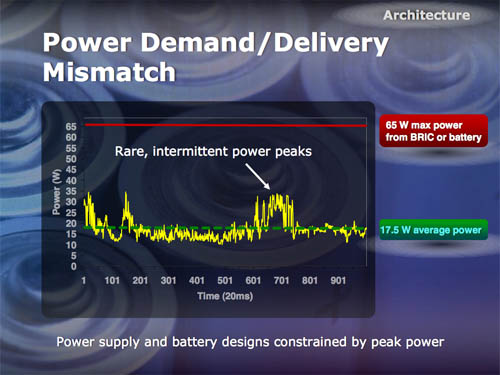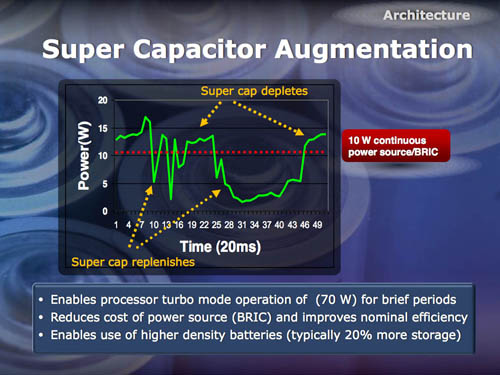This article is more than 1 year old
Intel Labs unveils PC power plans
'Humongous' savings, tiny batteries
Architecture: 'Super Capacitors'
A laptop's power brick or battery provides far more power than the system typically needs - the extra power sits there, unused, waiting for rare and unpredictable power peaks. According to Wang, a 65 watt power supply typically powers a system that needs an average of about 17.5 watts.

There's a lot of headroom between 65 watts and 17.5 watts
The basic concept behind Intel Lab's solution to this disparity is so simple that it's a wonder no one has implemented it before (at least to our knowledge): instead of a brick or battery that pumps out a steady 65W of power, Wang's engineers have added what Intel calls a "Super Capacitor" between a 10W battery or brick and the laptop's compute circuitry.
When power requirements rise above what the 10W supply can furnish, the capacitor - which has been charging when the laptop needed less than the available 10W - is notified that more power is needed. It then discharges, providing the intermittent juice boost that the laptop needs.

The "Super Capacitor" charges while idle, waiting to be of assistance
The most obvious benefit of this scheme - that is, most obvious beyond the simple need for less total power - is that 10W power bricks and batteries can be lighter and more compact than 65W units. But there's also a more subtle battery-boosting saving to be enjoyed.
"A battery has two parts," Wang said. "One is for the chemical reaction to create energy, and then another is the metal part that gets the energy out. And since you need a lot of energy for the [65W] worst case, you end up putting a lot of metal in there, and that occupies a lot of space, and we could have used that space for more chemical reaction material."
In current battery technology, Wang says: "Usually you use two-thirds of the space for chemical reaction and one-third to get the power out." In the Super Capacitor scenario, however, that ratio changes to 90 per cent of the space being used for the chemical reaction, and a mere 10 per cent needed to "get the power out."
Of course, one drawback of this scheme is immediately apprent: What if the processor and its associated circuitry needs more power for a longer period than the Super Capacitor can provide? This scheme might be just peachy for email, Flashless web surfing, word processing, and the like - but what about for the users who tax their systems for longer periods of time?
When asked about this, Wang said: "For those high-power users, they'll probably buy a [Core] i7 or i5 - I'm not a marketing guy, but they'll probably buy high-end products and their structure will be different."
But even a low-end user might run into times when the Super Capacitor–based system is over-taxed. Should that happen, Wang explained: "That's where our power management will kick in, and it will say, 'Oh, dangerous, dangerous! Red alert! There's no juice left and this thing is demanding more than 10W!' So we say 'Calm down, calm down, we'll just lower the frequency.'"
There are always trade-offs, it seems.
